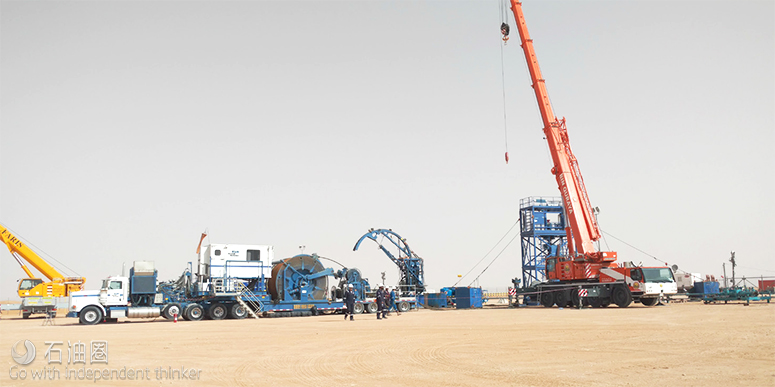Saudi Aramco and Baker Hughes announced today the first installation of the TransCoil rigless-deployed electrical submersible pumping (ESP) system, which is designed to help operators bring wells on production faster and lower the costs associated with installing and replacing ESPs. Because they can eliminate the need for a rig in fields where rig availability is a concern or where high intervention costs can limit artificial lift options, operators can minimize deferred production and lower their overall lifting costs to extend the economic life of their assets.
The TransCoil system―developed in participation with Saudi Aramco―features an inverted ESP system with the motor connected directly to a new, proprietary power cable configuration, eliminating the traditional ESP power cable-to-motor connection, which improves overall system reliability. Unlike wireline-deployed ESPs, the fully retrievable TransCoil system does not have an in-well “wet connection,” which requires a rig to pull and replace if the wet connection fails.
The innovative power cable design enhances the reliability of the deployment string compared to coiled tubing-deployed ESPs that simply pull the power cable through the coiled tubing. Extensive fatigue testing and thermal growth analysis were conducted at the Baker Hughes’ Coiled Tubing Research and Engineering Center to enhance materials selection and system design. The TransCoil system cable design also extends the operating range to 12,000 ft compared to traditional coiled tubing-deployed ESP systems, which are limited to approximately 7,000 ft because, at greater depths, the weight of the power cable will cause it to collapse inside the coiled tubing, creating an electrical failure.
The TransCoil system can be installed in 4½-in. to 9-in. casing in wells with flow rates up to 18,000 bpd. In mature offshore fields, where high intervention costs can limit the application of ESPs, the system can be deployed through the existing 4½-in. tubing, saving the time and money required to pull the existing completion. Another advantage of the TransCoil technology compared to wireline-deployed ESPs is that it can be installed through a deviation in the wellbore. This capability allows operators to land the ESP closer to the producing zone for greater reservoir pressure draw down and reserve recovery.
“With a large ESP installation base, including many ESPs installed in our offshore fields, the ability to rapidly deploy ESPs riglessly provides tremendous cost benefits to our overall operations. The TransCoil system is particularly beneficial in our challenging high H2S fields as the premium metallurgy in the system can significantly extend the ESP operational life in harsh environment wells,” said Nasir K. Al Naimi, V.P., Petroleum Engineering and Development at Saudi Aramco. “Collaboratively working with Baker Hughes, we have developed a solution that meets our immediate challenges and enables our long-term vision of one-day ESP change outs. We will push the envelope more to have the remaining part of our vision, which is to have 10-year ESP service life.”
“Working together with Saudi Aramco, we have addressed the industry’s critical need for a reliable alternative deployment option that reduces the cost and time associated with deploying ESP systems without introducing new potential failure modes,” said Ryan Moore, V.P. of artificial lift systems at Baker Hughes. “In the new normal for oil prices, this technology can be game-changing for operators looking for pathways to extend the productive life of their fields.”
Features
Proprietary TransCoil power cable:
– Protects power cable from the well environment
– Supports power cable over the entire deployment length
– Industry standard coiled tubing unit used for deployment and retrieval of ESP system
Bottom intake ESP system
– 3.75-in. and 4.50-in. OD ESP system
Transcoil Rigless Deployed ESP System Gets Stranded Production Back on Line, Reduces Installation Time by More than 50%
Location: Middle East
An operator in the Middle East was experiencing long lead times to get a rig on location to retrieve and install electrical submersible pumping (ESP) systems. Yearly rig schedules made it difficult to arrange unplanned workovers, resulting in down time of 3 to 6 months or longer. The operator was looking for an alternative deployment method to eliminate the down time and cost associated with using a rig to retrieve and install ESP systems.
Baker Hughes worked with the operator to develop a solution that not only eliminates the rig but also addresses harsh downhole conditions, including high levels of H2S in the fluid stream.
The first TransCoil system was installed in a well that had been waiting for a year for a rig to replace an ESP. The installation, including the mobilization time of a Baker Hughes coiled tubing unit, reduced overall installation time by 50% compared to a rig-deployed system. The alternative deployed technology reduced workover costs by approximately 50% compared to rig-deployed operations. The TransCoil ESP system brought 8,000 BOPD back on production without interrupting the operator’s established annual rig schedule.


 石油圈
石油圈
